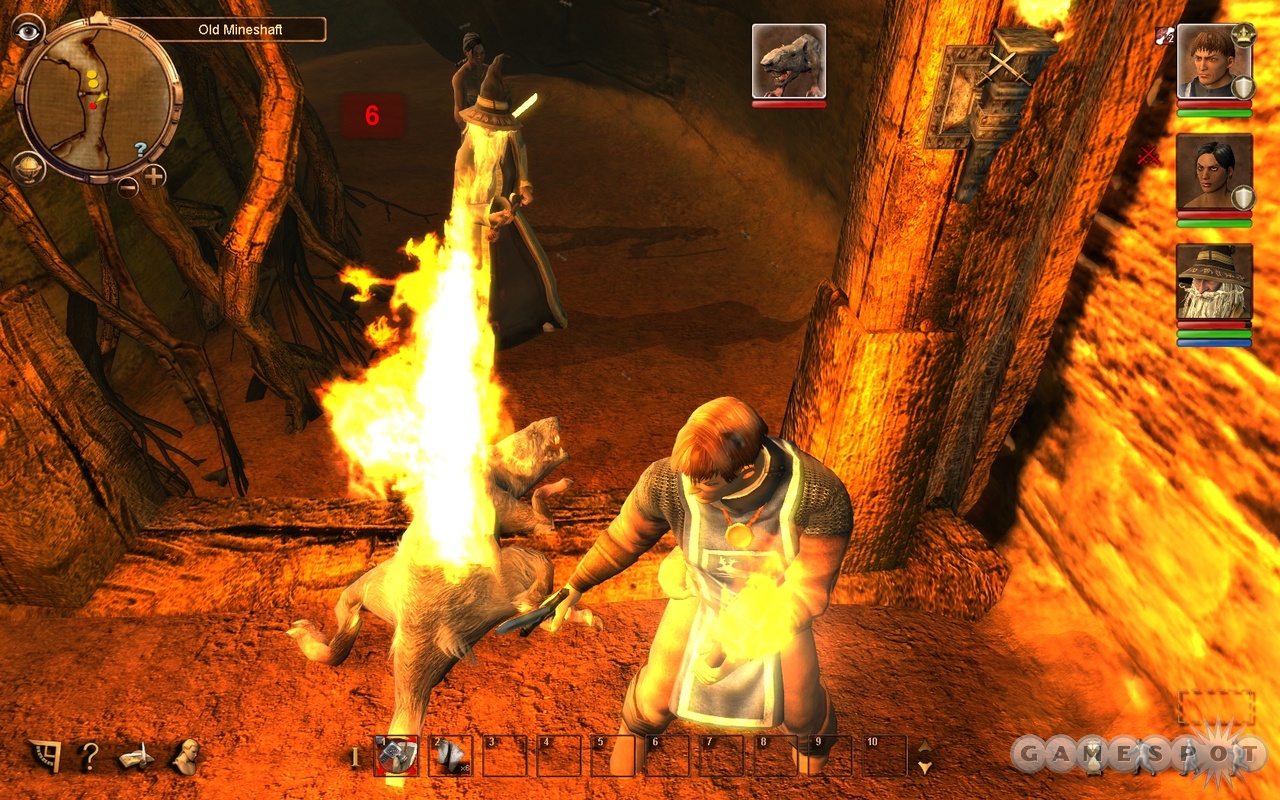Last year's hit from Germany, Drakensang: The Dark Eye, has arrived in North America with a budget price and a classic scope that evokes the likes of Baldur's Gate. Production values are wanting in spots, but even with voice acting that might make your ears bleed and some convoluted character development, this remains an involving, old-fashioned heroic saga. The Radon Labs-designed game still hits the spot if you're looking for a traditional RPG with just the right mix of wizards in pointy hats and unsung heroes looking to fulfill their destiny.
Drakensang's story and setting have been compiled from so many fantasy novels, movies, and games that Drakensang will initially cause deja vu. You play a stereotypical hero who starts off as a nobody, yet soon becomes a legendary adventurer as the fulfillment of--yep, you guessed it--a prophecy. Everything here seems to have been randomly pulled out of the grab bag of RPG cliches. Gruff but lovable dwarves, hippie elves who just want to be left alone, mysterious messages from old friends, rampaging goblin hordes, and forgetful mages who are mirror images of Gandalf make up the cast of characters in the medieval fantasy land of Aventuria. As with timeless RPGs such as Baldur's Gate, you manage an entire party of up to four adventurers. Quests are many and feature myriad goals that run the gamut from keep-busy jobs such as killing a white wolf and tracking down a stolen diadem to cleaning out a crypt of the undead and solving riddling rhymes. Just about the only touch of originality comes from the main plotline's focus on dragons, which at one time ruled the world before a scaly civil war.

The game's mechanics are derivative and cluttered up with extraneous rules taken from Drakensang's pen-and-paper inspiration, The Dark Eye. Characters are crammed with finicky stats, talents, and attributes that can be hard to come to grips with, especially in the beginning. Each hero comes with eight attributes, nine base values, five talent pools with five separate skills in each, a raft of combat talents dealing with each weapon type, three schools of special abilities, magic talents for spellcasters, and a recipe book for the alchemical, blacksmith, and archery goodies that you can put together on your own. Whew. In addition to all of this, there are a pile of races to choose from, all pulled from standard fantasy folk such as humans, elves, and dwarves, and in turn slotted into about 20 race-exclusive professions. For example, if you choose to play as an elf, you can become a ranger, fighter, or spellweaver. Pick a dwarf, and you're stuck with a mercenary, sapper, or prospector. And so on.
Documentation and in-game tips are plentiful, leaving you with a lot of reading to do when rolling up a character. You can cut to the chase and select an adventurer with prerolled skills and stats, along with a suitable randomly chosen goofy name such as Gerron Goose or Glombo of Wildfang. But the huge number of talents and stats attached to each adventurer means that doing so just drops you into the game with scarcely an idea of what you're doing. Any time saved on creating a hero is eaten up by the number of times you get killed due to not understanding what sort of character you're adventuring with and wrangling with choices whenever you level up later on. To develop a true understanding of abilities, you need to spend a good hour or so creating a character in the expert mode, tweaking the tons of skills and stats until you have an idea what's going on. Serious role-players will love this attention to detail; more casual fans may be overwhelmed.
A lot of attention has been paid to fine details that establish a feeling of venturing into real places. Every cave, chamber, and forest clearing has been dressed up like a movie set, with lots of dungeon accoutrements and trees adorning every place you go. All of these background effects can be a bit much, though. When adventuring outdoors, the dense foliage of the wilderness gets in the way so much that you have to constantly rotate the camera to keep an eye on your party. This problem is even worse indoors, given that the camera cannot be scaled back much beyond ceiling level. Instead of the bird's-eye view of the action provided in most third-person RPGs, here the camera locks in tight on your party leader, making it nearly impossible to scroll back far enough to see the way ahead. In the darkest passages, you have to navigate using the minimap because you simply cannot see well enough to move around properly in the main screen.

Sound consists of standard sword-smashing clangs and the celestial swooshes of spells, along with some of the most god-awful voice acting ever committed to a game. You almost wish that the developers had left the dialogue in German, because even though the end result would have been unintelligible to most of the North American audience, at least then the conversations would have sounded kind of cool. After being stuffed into English, every spoken line is wildly oversold with excessive shouting and exaggerated hand gestures. The lone saving grace is that most NPCs deliver their conversations through text after the opening blurt of words has brought shame to voice-only thespians everywhere. The core script itself has actually been written and translated well, with a minimum of the flouncy language that tends to creep into European RPG imports. On the other hand, most chats regarding quests are quite dull, which lessens the impact of saving the world D&D-style, but is still better than the florid alternative.
Larger-than-life RPG epics like Drakensang are few and far between these days. The story and quests are generic, and the character management is unnecessarily complex, but this is still a fairly captivating adventure that delivers most of what old-time RPG fans want and expect.